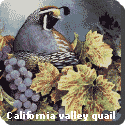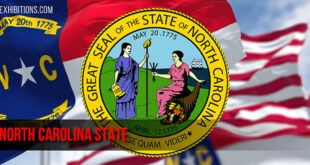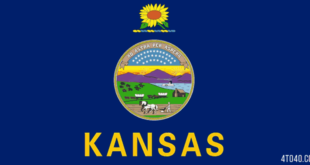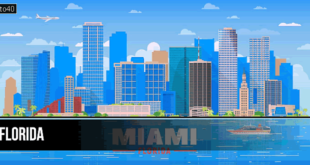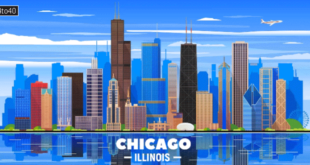California, a state of the far-western United States, is widely known for its great natural beauty, its highly productive farms and factories, and its innovative social and political ideas. Its many cities include LOS ANGELES, a major center of the entertainment and aerospace industries, and SAN FRANCISCO, a sophisticated financial center. Often depicted as a fabulous land of opportunity, the state has lured millions of migrants since the mid-19th century, when gold was discovered there, and by the late 1970s it was the nation’s most populous state.
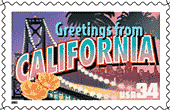 California is bordered by Oregon on the north, by Nevada and Arizona on the east, by Mexico on the south, and by the Pacific Ocean on the west. The state is named after a fictional island of great wealth described in a novel (published about 1500) by the Spanish writer Garci Ordonez de Montalvo; the name was probably first applied (early 16th century) to the southern tip of Baja California by the Spanish explorer Hernan Cortes.
California is bordered by Oregon on the north, by Nevada and Arizona on the east, by Mexico on the south, and by the Pacific Ocean on the west. The state is named after a fictional island of great wealth described in a novel (published about 1500) by the Spanish writer Garci Ordonez de Montalvo; the name was probably first applied (early 16th century) to the southern tip of Baja California by the Spanish explorer Hernan Cortes.
California State: Land & Resources
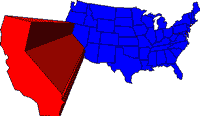 California is a state of great scenic beauty, and it is well endowed with natural resources. Its highest point is Mount WHITNEY (4,417 m/14,491 ft), the loftiest point in the conterminous United States; and its lowest point, in DEATH VALLEY (86 m/282 ft below sea level), is the lowest point in the Western Hemisphere.
California is a state of great scenic beauty, and it is well endowed with natural resources. Its highest point is Mount WHITNEY (4,417 m/14,491 ft), the loftiest point in the conterminous United States; and its lowest point, in DEATH VALLEY (86 m/282 ft below sea level), is the lowest point in the Western Hemisphere.
Physiographic Regions
California has a varied and complex topography, the main features of which are the large Central Valley and the mountain ranges that enclose it. The Central, or Great, Valley, about 805 km (500 mi) long and 80 km (50 mi) wide, includes two major drainage basins: the SACRAMENTO RIVER system, in the north, and the SAN JOAQUIN RIVER system, in the south. Both ultimately empty into the Pacific Ocean. In the extreme southern part of the valley is a region of interior drainage, formerly occupied in part by Tulare and Buena Vista lakes.
The Central Valley generally is very flat, with elevations of less than 150 m (492 ft). It is mostly overlain by deep deposits of fertile alluvium, washed down from the mountains. The valley is bounded on the northwest by the Klamath Mountains, a rugged, forested range, with peaks reaching an altitude of more than 2,700 m (8,900 ft). The southern portion of the CASCADE RANGE borders the Central Valley on the northeast. The Cascades include isolated lofty volcanic peaks, the highest of which is Mount SHASTA (4,317 m/14,162 ft), as well as cinder cones, lava flows, and beds of ash, pumice, and tuff. LASSEN PEAK (3,187 m/10,457 ft) is one of the two active volcanoes in the conterminous United States. Lassen last erupted in 1914-21.
To the east of the Central Valley is the great SIERRA NEVADA, a north-south mountain barrier with many peaks rising more than 4,267 m (14,000 ft); the highest point is Mount Whitney. The range is a vast fault block with a granite core. The western slopes are cut by deep river canyons, such as the Yosemite Valley, that were formed in part by glacial action. Historic DONNER PASS is part of an important route across the Sierra Nevada.
The Central Valley is bounded on the west and south by the COAST RANGES, which extend parallel to the Pacific from the Klamath Mountains to Point Conception, with a break at San Francisco Bay. Component parts of these mountains include the Diablo, San Rafael, Santa Cruz, and Santa Lucia ranges. The northern parts of the Coast Ranges are forested and have fertile valleys (such as the Napa Valley), whereas the drier southern portion is covered with chaparral, a dense brush, or with oak-grass woodlands. The SAN ANDREAS FAULT, a fracture in the Earth’s crust, cuts through the Coast Ranges; movements along the fault cause periodic earthquakes.
Southeast of the Coast Ranges are the Transverse Ranges, a group of east-west trending mountains that include the Santa Monica, San Gabriel, and San Bernardino mountains. The highest point is Mount San Gorgonio (3,506 m/11,502 ft), in the San Bernardino Mountains. The Transverse Ranges enclose many valleys and lowlands, but the only large expanse of flatland is the Los Angeles Lowland, the site of the city of Los Angeles. South of the Los Angeles Ranges are the Peninsular Ranges, part of a system that extends into the Baja California peninsula of Mexico.
To the east of California’s major mountain systems are extensive regions of arid basins and valleys, with several other mountain ranges. In the northeast and east-center are parts of the GREAT BASIN; the latter area includes Death Valley as well as the Panamint range. In southeastern California is the large MOJAVE DESERT and the Salton Trough, which includes the SALTON SEA and the IMPERIAL VALLEY.
The state has about 1,348 km (838 mi) of coastline along the Pacific Ocean. Much of it is rocky and rugged, such as in the Big Sur region, but southern California has numerous large sand beaches. The Channel Islands (see SANTA BARBARA ISLANDS), which include Santa Catalina Island, are located in the Pacific near Los Angeles.
Rivers and Lakes
The principal rivers of California are the Sacramento and San Joaquin, which merge shortly before emptying into the Pacific Ocean via San Francisco Bay. Most of the state’s other large rivers flow into either the Sacramento or the San Joaquin. Additional important rivers not part of these systems include the Colorado River, which forms California’s southeastern border; the Kern River, in the south central part of the state; and the Klamath River, in the northwest. Many of the state’s smaller streams flow only during a few months of the year.
California has many large natural lakes. These include Lake TAHOE, astride the border with Nevada; Goose Lake, straddling the boundary with Oregon; Honey Lake, in the northeast; and the shallow Salton Sea, in the south, formed (1905-07) by floodwaters of the Colorado River. The state also has numerous artificial lakes, created by dams on rivers. These include Lake Oroville, Clair Engle Lake, Folsom Reservoir, Lake Berryessa, and Shasta Lake.
Climate
California has a varied climate pattern, the result of its complex topography and wide latitudinal range. Most of the state has only two distinguishable seasons–a rainy period (October to April) and a dry period (May to September). Annual precipitation is greatest in the north, especially near the coast, which receives about 2,032 mm (80 in) of moisture yearly. The south gets much less precipitation; Los Angeles receives only about 381 mm (15 in) and San Diego just 254 mm (10 in). Desert areas receive even less moisture.
Temperatures are mild along the coast, with relatively small variations between the warmest and coolest months; the southern coast is somewhat warmer than the central and northern coasts. The average recorded January temperature in Los Angeles is 13 deg C (56 deg F), and in San Francisco it is 10 deg C (50 deg F); the mean recorded July temperature in Los Angeles is 22 deg C (72 deg F), and in San Francisco it is 15 deg C (59 deg F). The Central Valley often has a mild climate, but other parts of the interior are either markedly hotter (Death Valley and the Mojave Desert, for example) or colder (the lofty peaks of the Sierra Nevada).
Vegetation and Animal Life
California’s great climatic and topographic diversity is reflected in the variety of its plants and animals. Forests cover about 42% of the state; almost half the forestland is in California’s 22 national forests. The humid northwest has dense coniferous forests, which extend south along the coast past Monterey; these coastal forests include numerous tall trees, especially the redwood (ranging to about 113 m/371 ft high). The forests thin toward the east, and much of the Coast Ranges is covered with chaparral. The Sierra Nevada foothills and coastal southern California also have much chaparral. Higher parts of the Sierra Nevada and some sections of the Transverse and Peninsular ranges are covered by woodlands of conifers, especially yellow pine. The Sierra Nevada is noted for its massive sequoia trees. California’s deserts have a sparse cover of xerophytes (drought-resistant plants), including many types of cactus in the Mojave Desert.
Large mammals, such as deer, bears, and cougars, are found in the northwest and in the Sierra Nevada. Chaparral areas have deer, rabbits, coyotes, rattlesnakes, tortoises, and many rodents. Desert wildlife, surprisingly rich, includes bighorn sheep, wild burros, coyotes, hares, sidewinders (a variety of rattlesnake), and numerous lizards. The extremely rare California condor, the largest bird of North America, is found in the Transverse ranges. The state’s rivers and lakes contain salmon, bass, and trout; coastal marine waters are noted for their shellfish and grunion.
Historic Sites
Among California’s places of historic interest are Cabrillo National Monument, at San Diego, commemorating the voyage of the Spanish explorer Juan Rodriguez Cabrillo in 1542 (see History below); Fort Point National Historic Site, at San Francisco, with a large 19th-century fortification; John Muir National Historic Site, at Martinez, including the home of the famous naturalist; and several 18th-century Franciscan missions, at or near San Diego, San Juan Capistrano, Santa Barbara, San Luis Obispo, Carmel, and other places.
Tourism
California each year attracts millions of tourists, lured by the state’s equable climate and beautiful scenery, its outdoor recreation opportunities, and the cultural offerings. Popular urban tourist spots include the motion-picture and television studios of the Los Angeles area; DISNEYLAND, a large amusement park at Anaheim; the San Diego zoo and Sea World; and Fishermen’s Wharf, Chinatown, and other parts of San Francisco. Many persons visit the state’s five national parks (Kings Canyon National Park, Lassen Volcanic National Park, REDWOOD NATIONAL PARK, SEQUOIA NATIONAL PARK, YOSEMITE NATIONAL PARK) and its eight national monuments (including Death Valley National Monument, Devils Postpile National Monument, and Muir Woods National Monument), as well as other units of the National Park Service.
California State: History
When the first Europeans arrived, in the early 16th century, the region of California was inhabited by a relatively sparse Indian population, scattered in many small, fairly independent groups that lived mainly as hunter-gatherers. Among the Indian groups were the HUPA, POMO, Wishosk, and Yuki, in the north; the Costano, Miwok, Salinan, and Yokut, in the center; the Mono and Panamint, in the east; and the Chumash, Serrano, and Diegueno, in the south.
Juan Rodriguez CABRILLO, a Portuguese navigator exploring for Spain, was probably the first European to see California. Sailing north from present-day Mexico, he visited San Diego Bay in September 1542, before continuing on past San Francisco Bay, which he did not see. The next major voyage along the coast was made by the English navigator Sir Francis DRAKE, in 1579. He arrived in the San Francisco area and claimed the region of northern California, which he called Nova Albion, for England. Fearing English intrusion, the Spanish sent several coastal expeditions, including that of Sebastian VIZCAINO to Monterey Bay in 1602-03. But no European settlements were established until Captain Gaspar de PORTOLA, the Spanish governor of Baja California, led an expedition north in 1769-70, partly in order to offset Russian activity. During the journey, forts were established at San Diego and Monterey, thus asserting a minimum of Spanish control.
Father Junipero SERRA went along on the expedition, and in 1769 he founded a Franciscan mission, San Diego de Alcala, near modern San Diego. This was the first of a string of 21 missions, ranging to Sonoma (north of present-day San Francisco), founded by the Franciscans during the next 54 years. The Indians felt the economic and social presence of the Europeans mainly through the missions, as the Spanish officials tended to neglect California. The missions controlled much land, and, using Indian labor, they produced large quantities of cattle hides and tallow (the area’s chief exports at the time) and fruit and vegetables. The Indians living at the missions were forced to work hard and received few economic rewards; they were given instruction in Christianity, however, and were taught some new skills.
California was little affected by the political upheavals in Mexico during 1808-11. In 1812 the Russians established Fort Ross along the northern coast (near the mouth of the Russian River) as a trading and fur-trapping center, which they maintained until 1841. In 1821 Mexico gained independence from Spain, and in 1822 California (known as Alta California) became a province of the new nation. For a time, about 1825-35, the Mexicans sought to exert control over California, but they had little success, and the region generally was neglected thereafter. A major conflict between the central government of Mexico and California was over the missions. The Mexican government sought to secularize the missions by selling their great landholdings to private individuals, and after several false starts this was accomplished during 1834-40. Many large private estates were thus established.
During the 1840s a few hundred U.S. citizens moved into California to farm, hunt, and trade. They were aided by John A. SUTTER, a Swiss who held a vast tract of land at present-day Sacramento. In 1843-46 Captain John C. FREMONT led two U.S. government surveying expeditions into California. In May 1846, the United States went to war with Mexico over Texas (see MEXICAN WAR). The following month, before news of the outbreak of war had reached California, a group of U.S. citizens under the influence of Fremont captured the Mexican presidio at Sonoma and raised a flag with one star, a picture of a grizzly bear, and the words “California Republic” (see BEAR FLAG REPUBLIC). This short-lived event is known as the Bear Flag Revolt. On July 7, 1846, Commodore John D. Sloat claimed California for the United States by raising the U.S. flag over Monterey. This episode was followed by the easy conquest of California by Commodore Robert F. STOCKTON, General Stephen Watts KEARNY, and other U.S. soldiers. California was officially transferred to the United States by the Treaty of GUADALUPE HIDALGO, signed Feb. 2, 1848.
On Jan. 24, 1848, a few days before the treaty was signed, gold had been found at a sawmill (owned by Sutter) on the South Fork of the American River, at Coloma. News of the discovery spread rapidly, and a gold rush was soon underway, bringing thousands of “forty-niners” to stake claims in northern California. San Francisco grew as a gateway to the area. From 1848 to 1850 the state’s white population more than tripled, to 93,000 inhabitants. After heated discussions in the U.S. Congress concerning the spread of slavery, California was admitted to the Union as a nonslavery state on Sept. 9, 1850 (see COMPROMISE OF 1850); it was the country’s 31st state. California’s first capital was San Jose; the capital was moved later to Vallejo and then to Benicia before Sacramento became the permanent capital in 1854. Although proslavery sentiment was considerable in southern California, the entire state remained in the Union during the Civil War, a war that had little direct effect on Californians.
Gold production had peaked in 1852 and thereafter declined rapidly. During the 1860s agriculture grew in importance as productive fruit- and grain-producing farms were developed in the Central Valley, and viticulture flourished in valleys north of San Francisco. Economic growth was furthered by the completion, in 1869, of the first transcontinental railroad, which linked Sacramento with the rest of the nation. Four Californians–Charles Crocker, Mark Hopkins, Collis P. Huntington, and Leland STANFORD–helped finance the railroad, and their Southern Pacific Company exerted great influence over the economy and the political life of the state in the late 19th century. Some 30,000 Chinese laborers were brought to California to help build the railroad, and they remained in the state after its completion. When poor economic conditions in the 1870s led to a high rate of unemployment, the white settlers were bitter toward the Chinese, who were willing to work for low wages. Anti-Chinese riots occurred in San Francisco in 1877. In 1882 the federal government enacted a law prohibiting further Chinese immigration.
The economy of California improved in the 1880s, and southern California, especially the Los Angeles area, began a period of rapid growth. Citrus groves around Los Angeles started to produce large quantities of fruit in the late 1880s, major petroleum fields were discovered in the same region beginning in the early 1890s, and the first motion picture produced in southern California was completed in 1907. In 1906 San Francisco was devastated by a great earthquake and fire.
California politics, dominated for many years by the Southern Pacific Company, underwent major reforms in the early 20th century, especially during the governorship (1911-17) of Hiram W. Johnson, a founder of the Progressive party. During Johnson’s administration, the political power of the Southern Pacific was greatly reduced; the initiative, referendum, and recall were adopted (1911); a state budget system was created; and many other reforms were passed to make the state government more responsive to popular needs. California’s economy benefited from the opening (1914) of the Panama Canal (which greatly shortened the sea route between the east and west coasts) and from the many factories established in the state to help meet the requirements of the U.S. effort in World War I. The state’s population grew rapidly in the 1920s, increasing from 3,427,000 in 1920 to 5,677,000 in 1930, as farming and industry were developed. California was deeply affected by the Great Depression of the 1930s. The state’s high unemployment rate was exacerbated by the influx of many impoverished farmers from the Dust Bowl region of the American West. Such migrants were depicted in the novel The Grapes of Wrath (1939) by John STEINBECK, a California author noted also for his descriptions of life in his native Salinas Valley. California’s economy improved greatly during World War II, as the state became a major center for building aircraft and ships. During the war, persons of Japanese descent living in California were placed in detention camps both inside and outside the state, and much of their property was confiscated.
Prosperity continued into the postwar period, and the population increased at an amazing pace, jumping from 10,586,000 in 1950 to 15,717,000 in 1960. Most of the growth occurred in the south, where sprawling urban and suburban areas were linked by numerous limited-access highways. Able governors like Earl WARREN (in office, 1943-53) and Edmund G. “Pat” Brown (1959-67) helped Californians meet some of the social and economic problems that accompanied the rapid growth, but California was the scene of several major social protests in the 1960s.
California’s blacks, largely confined to ghetto districts in the Los Angeles and Oakland metropolitan areas, organized campaigns to end racial discrimination in housing, education, and employment. In 1965 rioting occurred in the predominantly black Watts district of Los Angeles, and similar violent outbursts by blacks occurred in several other California cities in the mid-1960s. At the same time the state’s Mexican-Americans, sought to improve their marginal existence. Cesar E. CHAVEZ attempted to organize migrant farm laborers, most of whom were of Mexican descent, but in the face of stiff opposition by farm owners he made little progress until the mid-1970s. The Free Speech Movement (which began in late 1964) at the University of California at Berkeley set a pattern for many other campaigns in the country to increase student influence over the management of institutions of higher education. Several major protest demonstrations against U.S. military involvement in Southeast Asia took place in California, mainly during 1965-71. The state also was a center of youthful counterculture groups, such as the hippies who lived in the HAIGHT-ASHBURY district of San Francisco in the mid-1960s.
In the 1970s, under Governors Ronald W. REAGAN (in office, 1967-75) and Edmund G. “Jerry” BROWN, Jr. (1975-83), the son of “Pat” Brown, California tried to meet such pressing environmental problems as air and water pollution and threats to the natural beauty of the coastline from development. In 1978, California voters overwhelmingly passed an initiative (called Proposition 13) that mandated a major reduction in property taxes. Under Governor George Deukmejian in the 1980s the state’s economy grew in most sectors; the most striking demographic development was the fast growth of the Asian segment of the population.
California State: Land
- Area: 424,000 sq km (163,707 sq mi); rank: 3d.
- Capital: Sacramento (1990 pop., 369,365).
- Largest city: Los Angeles (1990 pop., 3,485,398).
- Counties: 58.
- Elevations: Highest–4,417 m (14,491 ft), at Mount Whitney; lowest–86 m below sea level (-282 ft), at Death Valley.
 Kids Portal For Parents India Kids Network
Kids Portal For Parents India Kids Network


